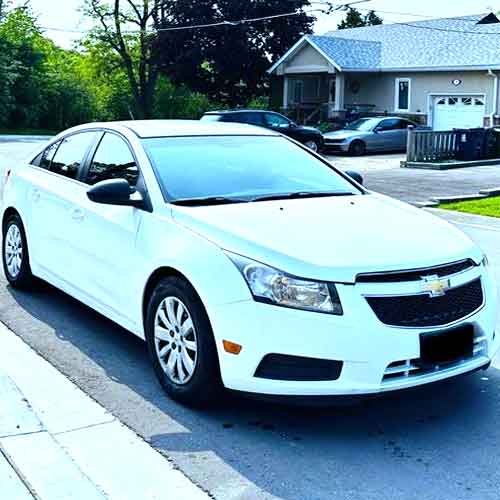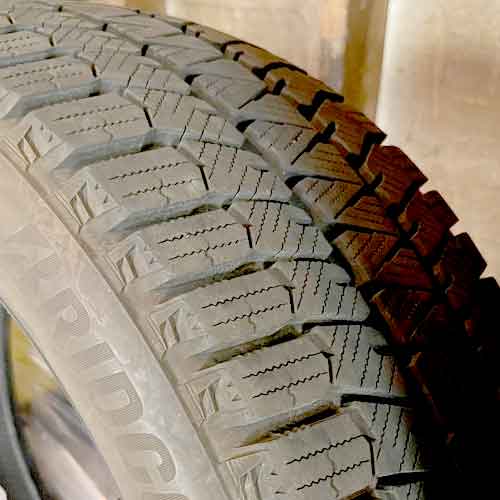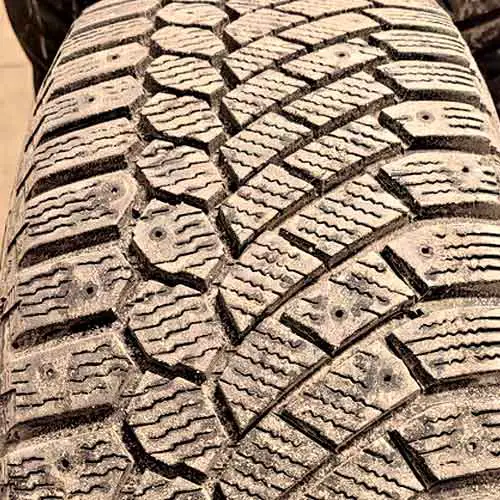The gloves are off as Gislaved Nordfrost 200, celebrated for its innovative snow-shedding tread design, takes on the Bridgestone Blizzak WS90, hailed for its optimal performance in icy conditions. As the snow flies, which tire will take the winter crown?

Table of Contents
Tire Sizes
The Bridgestone Blizzak WS90 comes in 52 total sizes in 15 to 19 inches (wheels) with following specs.
- Speed ratings: T or H.
- Load ratings: SL or XL.
- Tread depth: 11 or 12/32″.
- Weight: 17 to 29 lbs.
- Tread warranty: None.
Review this tire in greater detail: https://snowytires.com/bridgestone-blizzak-ws90-review/
On the other side, the Gislaved Nordfrost 200 comes in 14 to 19 inches wheels with following.
- Speed ratings: T only.
- Load ratings: SL and XL.
- Tread depth: 10/32″ on all.
- Weight: 15 to 35 lbs.
- Tread warranty: None.
Tread Appearance
The Bridgestone Blizzak WS90 is a tough tire for winter. It has a unique pattern on the outside, called the tread. Let’s delve deeper into its remarkable traits.

The tread surface presents three distinct sections, 2 outer and one in the middle, where I’d start from.
So here in the central rib, there’s aren’t any proper blocks formations, however they do make triangular shapes, with the two incisions.
And as these slits vary in length, these act as in-groove notches.
Moreover, these slits also join up with V shaped openings on either sides (consider them notches).
Moving towards shoulders, lugs also have two types of notches there.
You can see one of those laterally placed, while other seems to split up the blocks right in the middle. Both of them provide tremendous bite.
And yes, besides that, like any other winter tire, you see a ton of wave-like siping everywhere.
On the other hand, Gislaved Nordfrost 200 features a asymmetric tread design.

So here you get to have 4 total ribs, which form 3 longitudinal channels in the middle.
The two central ribs contain elongated lugs (at the right of the image), with sharp edges, in-groove notches and a ton of wave-like siping.
While the other rib contains smaller blocks, though with more edges, more prominent siping, and stud holes.
Moving towards shoulders, you get the similar tread features.
Although they carry in lengths considering both sides, they get to have similar stud holes and wave-like sipes on them.
All these create ample biters for all kinds of snowy terrains, as you’d see in the upcoming sections.
Ice Performance
On an ice, the Bridgestone Blizzak WS90 comes out with confidence, stopping an average of 10 feet shorter than the Gislaved Nordfrost 200 when it comes to braking.
This show of agility is also evident in acceleration tests as well, with the Blizzak hitting the 40 mph mark from a standing start a full second faster on average.
So, what’s the secret behind this icy mastery?
Well, its all attributed to the tire’s intricately designed biters scattered all over the tread.
For example, its (tread’s) central rib comes out with a symphony of slanted incisions of various sizes, V-shaped notches facing both lateral directions, and an abundance of siping, all of which contribute to superior ice-biting capabilities.
Noteworthy is the dual angle design of these biters, enhancing the grip further and thus, allowing for effective braking.
As for handling, the tire’s shoulder lugs, key components in this area, are embedded with biters facing both lateral and longitudinal directions, providing a well-rounded grip from every possible angle.
Similarly, the sipes also come with two distinct angles, mirroring those seen on the central lugs.
However, the Gislaved Nordfrost 200 seems a bit under-prepared for icy conditions, marked by larger tread voids and fewer notches.
The central tread area, critical for effective braking, struggles to secure a good enough grip on packed ice due to the tire’s wider lateral tread voids.
Additionally, the absence of multi-angled siping doesn’t help its case either.
Moreover, this shortfall extends to handling as well, where the lack of notches, there, results in longer handling times compared to its competition.
Though, things are significantly improved once you decide to put stud on the lugs, which are BTW, missing in WS90 (in all sizes).
Snow Performance
In a winter wonderland of snowy conditions, both tires truly make their mark, showcasing their prowess with commendable performances.
However, the Gislaved Nordfrost 200 appears to have a certain flair, particularly when navigating through fluffier snow terrains. And the secret to its superior traction? It’s all in the tread.
This tire dons an asymmetric tread pattern, with lugs that spread open like welcoming arms to the snowy surface.
These lugs make intimate snow-to-snow contact, enabling them to scoop up and retain the fluffy snow particles within their interlocking grooves and snow-vices.
This creates a layer of captured snow, paving the way for the tread to maintain contact with the ground using this snowy buffer. After all, snow shares a better bond with its kindred flakes than with rubber, enhancing traction significantly.
On the flip side, the Bridgestone Blizzak WS90 is somewhat of a snow minimalist, featuring a more closed design with a continuous running rib at the center and lacking the interlocking groove structure.
This means its tread is somewhat reserved when it comes to collecting snow, giving its competitor the upper hand.
Dry Traction
Dry grip hinges on the extent of the rubber’s contact with the ground, and 2 very different, yet crucial components come into play here, namely, directional grip and lateral traction.
Directional Grip
The effectiveness of the directional grip rests on the central area of the tread. And in this regard, the Blizzak WS90, with its continuous running rib there, ensures persistent surface contact as the tire rolls straight, leading to superior performance.
So you get shorter braking distances here on average, along with acceleration times.
Handling
Handling depends on shoulders and tire’s overall weight.
As the tire corners, its weight shifts towards the edges of the tread (aka shoulders), and how well they contact the ground becomes crucial.
And in this regard, the Gislaved Nordfrost 200, with its wider grooves, doesn’t quite measure up to the Blizzak.
Moreover, the tire’s greater weight also affects its performance. This added weight precipitates increased lug movement as the tire navigates corners, which subsequently weakens steering feedback.
Wet Traction
Wet traction is primarily influenced by two key factors: tread design and rubber compound.
In this context, even though both the Bridgestone Blizzak WS90 and the Gislaved Nordfrost 200 come equipped with abundant siping and thermally adaptive, soft rubbers, the Blizzak WS90 still offers slightly a better performance.
And this is because of the tire’s mixture of both rectilinear and interlocking sipes, which display a better proficiency at soaking up water particles encountered by the tire.
Moreover, you also get sipes with multiple angles, which enhance the tire’s grip as it maneuvers around corners. In such scenarios, water is absorbed into the slits, and the biters/sipes oriented parallel to the tire’s motion ensure the necessary grip.
On the other hand, the Gislaved Nordfrost 200 features siping predominantly in a lateral orientation. So it’s not quite there, if you know what I mean.
Though its hydroplaning resistance performance is quiet commendable, no doubt.
Upon testing, this tire indeed presented slightly superior “float speeds” in both curved and straight aquaplaning tests.
BTW, for folks who don’t know, the float speeds are simply maximum (fastest) speed a tire can achieve over standing water, before it starts to float.
And the Nordfrost offers better with its superior inter-connectivity of its grooves/channels.
So the tire’s tread disperses water efficiently in all directions, outshining its counterpart, which features a continuous central rib that somewhat obstructs the water’s path (most laterally).
Fuel Economy
The tire’s adhesion to the surface and its structural weight significantly impact fuel consumption.
And considering both it can be explained why the Gislaved Nordfrost 200 is taking the back seat here.
The tire’s considerable weight enhances the overall rolling resistance, while its relatively wider tread voids generate increased friction as the tire navigates the tarmac.
However, it’s worth noting that the tire’s performance markedly improves in extreme winter temperatures.
Contrarily, the Bridgestone Blizzak WS90, being lighter and equipped with longitudinally aligned ribs, allows for better streamlining as compared to the asymmetric pattern of its competitor.
This design promotes smoother straight-line travel, such as on highways, resulting in more efficient fuel consumption by curtailing energy wastage.
Comfort Levels
When considering tire comfort, several factors come into play, including road noise, vibration absorption, tire construction, material composition, and yes, the tread pattern. And considering all, it can be seen why we have some mixed results comparing both tires.
In case of noise, which gets generated when air particles are colliding with the tread walls, the Bridgestone Blizzak WS90 emerges slightly ahead of its competitor, thanks to it’s slightly less voided structure.
So the tire does not give as much room for air to hit around, as much as it does in case of Nordfrost 200.
Though this Gislaved emerges superior in the vibration absorbing tests, as it offers marginally superior cushioning when encountering bumps.
Tread Life
Tread durability is another aspect that’s significantly influenced by rolling resistance. In this arena, the Blizzak WS90 manages to surpass its competitor.
The tire’s lighter weight translates into less force exerted by its tread blocks onto the road surface. This, in turn, results in reduced friction and slows down the rate of rubber degradation.
In contrast, the Gislaved Nordfrost 200 carries a heavier weight and concentrates this additional burden on a smaller rubber surface due to its comparatively wider tread voids.
This configuration results in each lug bearing a greater pressure, accelerating tread wear and potentially reducing the tire’s overall lifespan.
However, it’s crucial to point out that the performance disparity between the two tires is not vast. This perhaps explains why neither tire offers warranties.
Summing Up
Ultimately, the verdict comes down to this.
When it comes to maneuvering on fluffy snow, the NordFrost 200 holds an edge. However, the Bridgestone Blizzak WS90 reigns supreme on packed snow and ice, demonstrating superior braking distances and handling times.
When assessing performance on tarmac, the Blizzak WS90 outshines in both wet and dry conditions. Nevertheless, the Gislaved Nordfrost 200 claims the crown when it comes to hydroplaning resistance.
Aside from these specifics, both tires deliver commendable ride comfort. The Blizzak WS90 provides a quieter journey, whereas its competitor, the Nordfrost 200, excels in absorbing bumps.